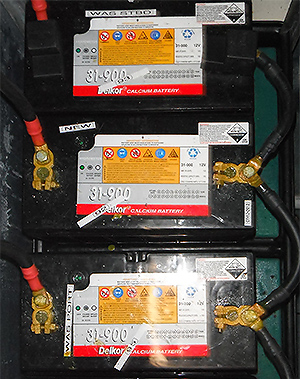Many specifications and performance standards have been developed to evaluate batteries and measure their power. Several rating methods are used to provide the market, the consumer, and the seller with meaningful battery information. These rating methods are explained below.
 Battery Rating Methods
Battery Rating Methods
Cold Cranking Amps (CCA)
The CCA rating represents in amps the current flow the battery can deliver for 30 seconds at 0oF without dropping below 1.2 volts per cell (total of 7.2 volts for a 12-volt battery). The higher the number, the more amps it can deliver to crank an engine.
Marine Cranking Amps (MCA)
Batteries designed for marine use may be rated at MCA instead of CCA. The MCA rating method measures battery output at 32oF, not 0oF. A battery's MCA rating will be one-third higher than its CCA rating would be.
To compare two batteries when one has an MCA rating and the other has a CCA rating, multiply the CCA rating by 1.3 for the equivalent MCA rating. Or, multiply the MCA rating by 0.77 for the equivalent CCA rating. Example:
500 CCA x 1.3 = 650 MCA or 650 MCA x 0.77 = 500 CCA
Reserve Capacity
The amount of reserve capacity represents the time in minutes a fully charged battery can deliver 25 amps at 80oF without dropping below 1.75 volts per cell (total of 10.5 volts for a 12-volt battery). The reserve capacity rating defines the length of time a vehicle can be driven after its charging system fails while supplying power for ignition, lighting, and other accessories. The higher the number of minutes, the longer it will deliver 25 amps at 80oF.
Ampere-Hour Rating
The ampere-hour rating method is also called the 20-hour rating method. This rating represents the steady current flow the battery will deliver for 20 hours at 80oF without dropping below 1.75 volts per cell (total of 10.5 volts for a 12-volt battery). For example, a battery that will continuously deliver 3 amps for 20 hours is rated as a 60 ampere-hour battery.
Most Australian battery manufacturers now use the CCA rating method instead of the traditional ampere-hour rating method. Adding confusion, MCA ratings are beginning to appear on marine batteries. Be sure you know the difference between batteries.
Test Battery Condition
Testing is required to determine the ability of a battery to function properly. The accuracy of the testing changes with temperature, specific gravity, age of the battery, type of battery, etc. An accurate test has more than one step.
Step 1: Visual Inspection
Step 2: Specific Gravity (Hydrometer) Test
Step 3: 421 Test *
Step 4: Load Test
Testing Cautions. Wear safety glasses. DO NOT break live circuits at battery terminals. When testing, be certain to remove gases at battery cover caused by charging.
*"421" and Load Test equipment is available from many automotive test equipment suppliers.
Step 1: Visual Inspection
- Check for obvious damage, such as a cracked or broken case that shows loss of electrolyte. Check around the top of the case and around the posts as well.
- Obvious damage ? Replace battery.
- No obvious damage ? Check electrolyte level.
- Below top of plates in one or more cells ? Add water to just above separators but not to split ring. Charge for 15 minutes at 15-25 amps with non-flame arrestor vent caps removed but leave flame arrestor caps in place.
- Electrolyte level above top of plates in all cells ? Proceed to Step 2.
Step 2: Specific Gravity (Hydrometer) Test
- 50 points or more variation between highest and lowest cell ? Replace battery.
- Less than 50 points variation between highest and lowest cell ?
- Specific gravity 1.100 at 80oF or more in all cells ? If 421 Tester is available, go to Step 3. If not available, go to Step 4 (6 and 8 volts, proceed to Step 4).
- Specific gravity less then 1.100 in one or more cells ? Proceed to Step 4.
Step 3: 421 Test
- Connect 300 amp load for 15 seconds (421 Test).
- Meter reading "Bad'? Replace battery.
- Meter reading "Good" ? No history of trouble ? Fully charge, clean, add water to split ring and return battery to service .
- History of trouble ? Proceed to Step 4.
Step 4: Load Test
Charge battery, if necessary, until all cells are at least 1.200 specific gravity. Remove all vent caps.
- Unable to obtain specific gravity of 1.200 at 80oF in all cells ? Replace battery.
- Specific gravity of 1.200 or more at 80oF in all cells ? Connect 300 amp load for 15 seconds.
- "Smoke" in one or more cells ? Replace battery.
- No "smoke" ?
- Place thermometer in one cell.
- Apply load equal to 3 times the ampere-hour rating of the battery (2 times for 6-volt batteries).
- Read voltage at 15 seconds with load connected.
- Remove load and read electrolyte temperature, then compare voltage and temperature readings with BATTERY VOLTAGE and TEMPERATURE CHART (Fahrenheit).
- Less than voltage on chart ? Replace battery.
- Same as or greater than voltage on chart ? Fully charge, clean, add water to split ring and return battery to service.
Note: Voltage must not drop below minimum listed at given temperature when battery is subjected to the proper load for 15 seconds and is 1.200 specific gravity at 80oF or more.
